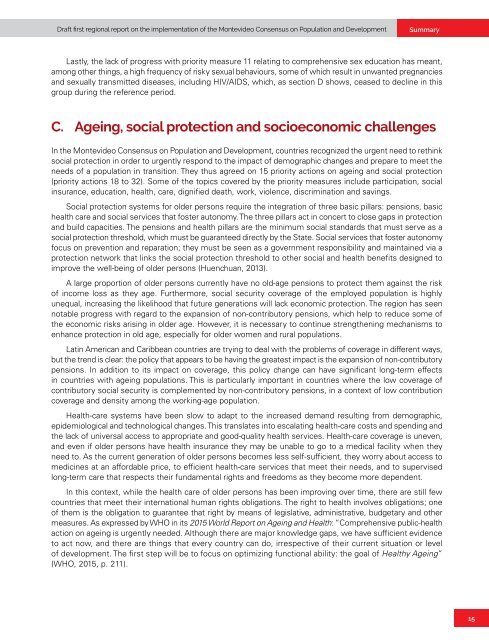Draft first regional report on the implementation of the Montevideo Consensus on Population and Development
This draft report seeks to give an account of progress in the implementation of the priority measures of the Montevideo Consensus on Population and Development in the region, as well as the differences between countries in terms of the degree of implementation. By highlighting relevant national experiences, it also seeks to facilitate the exchange of good practices among countries so that they can benefit from each other in their efforts to advance the implementation of the actions of the Montevideo Consensus.
This draft report seeks to give an account of progress in the implementation of the priority measures of the Montevideo Consensus on Population and Development in the region, as well as the differences between countries in terms of the degree of implementation. By highlighting relevant national experiences, it also seeks to facilitate the exchange of good practices among countries so that they can benefit from each other in their efforts to advance the implementation of the actions of the Montevideo Consensus.
Create successful ePaper yourself
Turn your PDF publications into a flip-book with our unique Google optimized e-Paper software.
<str<strong>on</strong>g>Draft</str<strong>on</strong>g> <str<strong>on</strong>g>first</str<strong>on</strong>g> <str<strong>on</strong>g>regi<strong>on</strong>al</str<strong>on</strong>g> <str<strong>on</strong>g>report</str<strong>on</strong>g> <strong>on</strong> <strong>the</strong> implementati<strong>on</strong> <strong>of</strong> <strong>the</strong> M<strong>on</strong>tevideo C<strong>on</strong>sensus <strong>on</strong> Populati<strong>on</strong> <strong>and</strong> <strong>Development</strong><br />
Summary<br />
Lastly, <strong>the</strong> lack <strong>of</strong> progress with priority measure 11 relating to comprehensive sex educati<strong>on</strong> has meant,<br />
am<strong>on</strong>g o<strong>the</strong>r things, a high frequency <strong>of</strong> risky sexual behaviours, some <strong>of</strong> which result in unwanted pregnancies<br />
<strong>and</strong> sexually transmitted diseases, including HIV/AIDS, which, as secti<strong>on</strong> D shows, ceased to decline in this<br />
group during <strong>the</strong> reference period.<br />
C. Ageing, social protecti<strong>on</strong> <strong>and</strong> socioec<strong>on</strong>omic challenges<br />
In <strong>the</strong> M<strong>on</strong>tevideo C<strong>on</strong>sensus <strong>on</strong> Populati<strong>on</strong> <strong>and</strong> <strong>Development</strong>, countries recognized <strong>the</strong> urgent need to rethink<br />
social protecti<strong>on</strong> in order to urgently resp<strong>on</strong>d to <strong>the</strong> impact <strong>of</strong> demographic changes <strong>and</strong> prepare to meet <strong>the</strong><br />
needs <strong>of</strong> a populati<strong>on</strong> in transiti<strong>on</strong>. They thus agreed <strong>on</strong> 15 priority acti<strong>on</strong>s <strong>on</strong> ageing <strong>and</strong> social protecti<strong>on</strong><br />
(priority acti<strong>on</strong>s 18 to 32). Some <strong>of</strong> <strong>the</strong> topics covered by <strong>the</strong> priority measures include participati<strong>on</strong>, social<br />
insurance, educati<strong>on</strong>, health, care, dignified death, work, violence, discriminati<strong>on</strong> <strong>and</strong> savings.<br />
Social protecti<strong>on</strong> systems for older pers<strong>on</strong>s require <strong>the</strong> integrati<strong>on</strong> <strong>of</strong> three basic pillars: pensi<strong>on</strong>s, basic<br />
health care <strong>and</strong> social services that foster aut<strong>on</strong>omy. The three pillars act in c<strong>on</strong>cert to close gaps in protecti<strong>on</strong><br />
<strong>and</strong> build capacities. The pensi<strong>on</strong>s <strong>and</strong> health pillars are <strong>the</strong> minimum social st<strong>and</strong>ards that must serve as a<br />
social protecti<strong>on</strong> threshold, which must be guaranteed directly by <strong>the</strong> State. Social services that foster aut<strong>on</strong>omy<br />
focus <strong>on</strong> preventi<strong>on</strong> <strong>and</strong> reparati<strong>on</strong>; <strong>the</strong>y must be seen as a government resp<strong>on</strong>sibility <strong>and</strong> maintained via a<br />
protecti<strong>on</strong> network that links <strong>the</strong> social protecti<strong>on</strong> threshold to o<strong>the</strong>r social <strong>and</strong> health benefits designed to<br />
improve <strong>the</strong> well-being <strong>of</strong> older pers<strong>on</strong>s (Huenchuan, 2013).<br />
A large proporti<strong>on</strong> <strong>of</strong> older pers<strong>on</strong>s currently have no old-age pensi<strong>on</strong>s to protect <strong>the</strong>m against <strong>the</strong> risk<br />
<strong>of</strong> income loss as <strong>the</strong>y age. Fur<strong>the</strong>rmore, social security coverage <strong>of</strong> <strong>the</strong> employed populati<strong>on</strong> is highly<br />
unequal, increasing <strong>the</strong> likelihood that future generati<strong>on</strong>s will lack ec<strong>on</strong>omic protecti<strong>on</strong>. The regi<strong>on</strong> has seen<br />
notable progress with regard to <strong>the</strong> expansi<strong>on</strong> <strong>of</strong> n<strong>on</strong>-c<strong>on</strong>tributory pensi<strong>on</strong>s, which help to reduce some <strong>of</strong><br />
<strong>the</strong> ec<strong>on</strong>omic risks arising in older age. However, it is necessary to c<strong>on</strong>tinue streng<strong>the</strong>ning mechanisms to<br />
enhance protecti<strong>on</strong> in old age, especially for older women <strong>and</strong> rural populati<strong>on</strong>s.<br />
Latin American <strong>and</strong> Caribbean countries are trying to deal with <strong>the</strong> problems <strong>of</strong> coverage in different ways,<br />
but <strong>the</strong> trend is clear: <strong>the</strong> policy that appears to be having <strong>the</strong> greatest impact is <strong>the</strong> expansi<strong>on</strong> <strong>of</strong> n<strong>on</strong>-c<strong>on</strong>tributory<br />
pensi<strong>on</strong>s. In additi<strong>on</strong> to its impact <strong>on</strong> coverage, this policy change can have significant l<strong>on</strong>g-term effects<br />
in countries with ageing populati<strong>on</strong>s. This is particularly important in countries where <strong>the</strong> low coverage <strong>of</strong><br />
c<strong>on</strong>tributory social security is complemented by n<strong>on</strong>-c<strong>on</strong>tributory pensi<strong>on</strong>s, in a c<strong>on</strong>text <strong>of</strong> low c<strong>on</strong>tributi<strong>on</strong><br />
coverage <strong>and</strong> density am<strong>on</strong>g <strong>the</strong> working-age populati<strong>on</strong>.<br />
Health-care systems have been slow to adapt to <strong>the</strong> increased dem<strong>and</strong> resulting from demographic,<br />
epidemiological <strong>and</strong> technological changes. This translates into escalating health-care costs <strong>and</strong> spending <strong>and</strong><br />
<strong>the</strong> lack <strong>of</strong> universal access to appropriate <strong>and</strong> good-quality health services. Health-care coverage is uneven,<br />
<strong>and</strong> even if older pers<strong>on</strong>s have health insurance <strong>the</strong>y may be unable to go to a medical facility when <strong>the</strong>y<br />
need to. As <strong>the</strong> current generati<strong>on</strong> <strong>of</strong> older pers<strong>on</strong>s becomes less self-sufficient, <strong>the</strong>y worry about access to<br />
medicines at an affordable price, to efficient health-care services that meet <strong>the</strong>ir needs, <strong>and</strong> to supervised<br />
l<strong>on</strong>g-term care that respects <strong>the</strong>ir fundamental rights <strong>and</strong> freedoms as <strong>the</strong>y become more dependent.<br />
In this c<strong>on</strong>text, while <strong>the</strong> health care <strong>of</strong> older pers<strong>on</strong>s has been improving over time, <strong>the</strong>re are still few<br />
countries that meet <strong>the</strong>ir internati<strong>on</strong>al human rights obligati<strong>on</strong>s. The right to health involves obligati<strong>on</strong>s; <strong>on</strong>e<br />
<strong>of</strong> <strong>the</strong>m is <strong>the</strong> obligati<strong>on</strong> to guarantee that right by means <strong>of</strong> legislative, administrative, budgetary <strong>and</strong> o<strong>the</strong>r<br />
measures. As expressed by WHO in its 2015 World Report <strong>on</strong> Ageing <strong>and</strong> Health: “Comprehensive public-health<br />
acti<strong>on</strong> <strong>on</strong> ageing is urgently needed. Although <strong>the</strong>re are major knowledge gaps, we have sufficient evidence<br />
to act now, <strong>and</strong> <strong>the</strong>re are things that every country can do, irrespective <strong>of</strong> <strong>the</strong>ir current situati<strong>on</strong> or level<br />
<strong>of</strong> development. The <str<strong>on</strong>g>first</str<strong>on</strong>g> step will be to focus <strong>on</strong> optimizing functi<strong>on</strong>al ability: <strong>the</strong> goal <strong>of</strong> Healthy Ageing”<br />
(WHO, 2015, p. 211).<br />
15


















